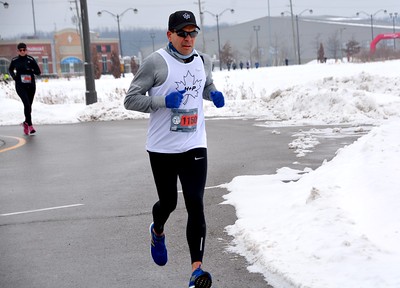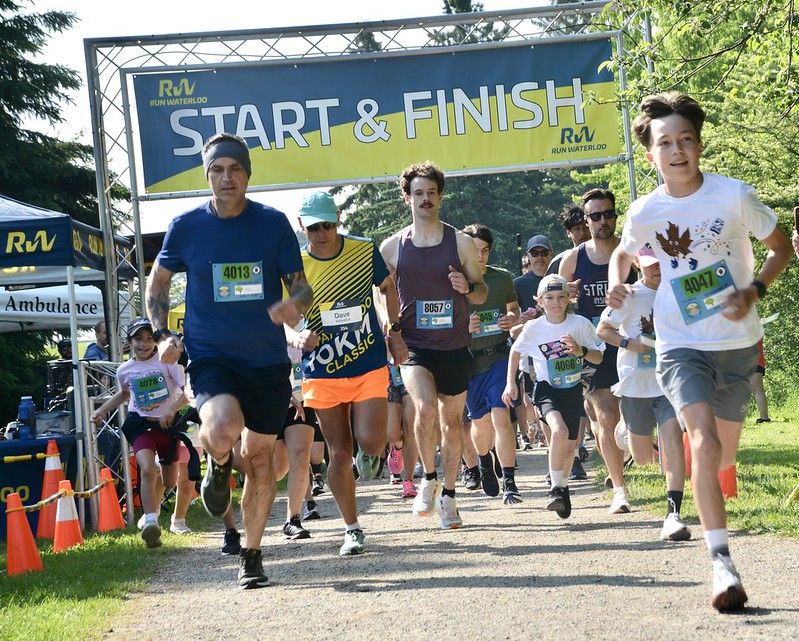In light of the COVID-19 situation, we have some time until we know when our next A-race will be. As a result, some athletes I work with have been analyzing their winter performances and workouts in an attempt to gauge their current fitness and make training plans moving forward.
As I have written about in the past, there are many things other than just your VO2max and running economy that impact what the clock shows on race day. For instance, I’ve explored how heat slows you down, light shoes make you go faster, stretching slows you down, carbs make you run faster, courses with corners slow you down, how beat juice might speed you up… The list goes on!

With all of those factors, I think practicing a balanced, evidence-based implementation of their principles is important. We want to have an educated idea of just how much each can slow you down, but also keep in mind the studies are limited in how accurately they apply to us.
With all this, let’s see what researchers show about how running in the cold impacts performance. The interesting thing to me is that there just isn’t as much research out there as I thought! Additionally, a key variable to consider is that a cold environment does not necessarily mean the individual is cold (actually often we can overheat by dressing too warmly). On the other side of the coin, there seems to be more research on performing in the heat, and consistently we know that when it’s hot out, you’re actually going to be hot. There are also other variables such as traction and weight of clothing that we have to take into consideration in real-world circumstances when running in the cold. All that being said, let’s see what some of the studies out there show!
Studies on performing in the cold
Extreme cold environment before
To start, one study produced by Patton and Vogel, looked at acute cold exposure over a 30h period (yes 30 HOURS). It’s kind of a weird study design but interesting nonetheless.
First, they tested the subjects beforehand for V02max (max ability to consume oxygen) and a time-to-exhaustion test at 75-80% of that VO2 max. Then, they would put them in a chamber for 30 hours at 20°C or -20°C and repeat the test on the second day.
In summary, they found that throughout the test in the colder chamber, they did not see a noticeable difference in heartrate or oxygen consumption. However, despite this, researchers noted a 38% decrease in time-to-exhaustion.
To be clear, this study is pretty extreme and may not be that relevant to us when it comes to estimating the magnitude of our slow down. When would you ever stay in -20°C conditions the entire day before your race? I think nobody will be surprised to see an extreme circumstance like this resulting in an extreme drop in performance.
However, what we can get out of this study is the relationship between oxygen intake vs. time-to-exhaustion while in the cold. This study, along with all others like it, seem to reveal a similar ability to consume oxygen at a given temperature despite a drastic drop in performance. This points to a significant component of the slow down likely being cognitive in origin.
Cold-ish during
A study that takes a more applicable look at how cold slows us down is this one published in Medicine and Science in Sports and Exercise. In the study, athletes were put through a time-to-exhaustion test on a bike at 4 different temperatures (~ 4°C, 11°C, 21°C, 31°C).
To no surprise, the 30°C trial resulted in the worst performance/shortest time-to-exhaustion. Interestingly, the 11°C trial out-performed the 4°C trial by 15%!
Do I think that you will actually run 15% faster in 11°C vs 4°C? Definitely not. There are so many other variables at play including the small sample size, cycling instead of running, the trial taking place at a very steady 70% of a V02 max rather than racing to the best of your ability; the list goes on.
However, the most CRUCIAL thing to consider is that these individuals did not dress for the 4°C temperature (shorts, socks only for all trials with the addition of gloves on the colder trials). Had they worn an appropriate amount of clothing for that temperature, as we could and would in the real world, would they have performed as well? That’s what the next study will look at.
Running in the cold with warm-ish clothing
This study helps to answer the question posed by the above study. Can we modify our performance in moderately cold temperatures by wearing the correct clothing? This study, completed in 2012, looked at the impact of 6 different temperatures on a running time-to-exhaustion test (-14°C and -9°C), cool (-4°C and 1°C) and moderate warm (10°C and 20°C).
A nice caveat with this study is that the subjects completed the trials in a cross-country ski suit.
Part of what they found was that the best performance came at the moderate temperature group (-4° and 1°C).
As with the other studies, they also showed there was no change in ability to consume oxygen. Once again, this points to cognitive reasons explaining the slow down.
From a magnitude standpoint, you can see the time-to-exhaustion results for all trials in this graph. As you can see, the moderate temperatures (middle 2 bars) revealed the best TTE results. From a % standpoint, as an example, you can see the 1°C trial performed just over ~10% better than the colder trials.

This study is fairly applicable to us because (1) it actually involves running and (2) it replicates (to some extent) what we actually wear when racing and training in the winter. Studies like this make it clear that even with reasonably warm attire, moderate temperatures close to 0° out-perform the colder temperature trials.
As a side note, it’s important to realize that this study does not point to 10°C being worse than temperatures close to 0°C, which would go against many other studies in this field. Instead, it shows 10°C is worse than 0°C if you’re competing in your activity in a XC ski suit!
Practical applications:
So, just how much does running in the cold slow us down? As you can see, it’s a multifactorial question that requires a multifactorial answer and analysis of your specific circumstances.
Extreme cold
I think what you can be confident of is if your performance in question was in extreme cold (below -15° C), you were likely so slow that the pace doesn’t mean anything, and you should just base your analysis of your performance off of effort, volume, and perhaps those around you.
Moderate cold
In moderately cold temperatures i.e. -14°C up to -10°C, if you were dressed properly, I think it’s very reasonable to take into account studies like the XC ski suit one from above, cut their lost time in half, and incorporate it into your analysis with reasonable confidence. In other words, barring additional lost time due to factors such as traction, thinking you were 5% slower at -14°C then you would have been at 0°C with proper clothing or 9°C with shorts/singlet is reasonable.
Cold-ish
Then, anything in the -9°C up to 0°C range becomes a lot murkier. Likely, you are still a little slower when closer to -9°C, but it would be difficult to put a precise number on it. In these cases, maybe rather than trying to know exactly how much slower you were, take solace in the fact that it likely did hurt you at least a little and worse case, you are marginally more fit than what that performance reveals.
There’s my convoluted answer as to how much slower running in cold temperatures makes you. This, believe it or not, is still a highly simplified version of the truth. If you want more clarification, feel free to reach out; I love discussing these topics! Hopefully this helps you to gauge how fit you really were through the colder winter months and also helps to provide some motivation and optimism in training through this COVOD-19 situation solo!






